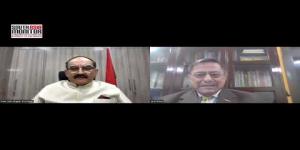Pakistan’s otherwise predictable election seeks to involve youth
Besides youth, efforts have also been made to increase women’s inclusion in electoral politics. Section 206 of the Elections Act 2017 mandates at least 5 per cent women's representation in general seats. However, major political parties often award tickets to women for unwinnable seats and focus on swing constituencies.

A funky new music video titled “Vote Tey Chadiya, Vote Te Dala” (I voted!) aims to motivate Pakistan’s youth to head to the polls scheduled for Thursday, February 8.
Election gatherings emerged a tad late in the country this time, as did the party campaigns and manifestos. Election-related activities like posters, banners, and political rallies are lower than usual, and streets and neighbourhoods are not as tense as they generally are ahead of polls - perhaps because people feel they already know who will win.
In contrast, the two-and-a-half-minute video released on January 24 on YouTube with the tagline "Your voice matters!" set to a catchy local hip-hop and rap song shows a diverse populace enthusiastic about voting.
VIDEO LINK: ‘Election 2024: UNDP Pakistan https://youtu.be/UWonKBZJLxo?si=wlX37u2pYsRJwLcj
The video is among several United Nations Development Programme Pakistan (UNDP) engagements in the country on various civic issues, which include the training of presiding and returning officers at the poll booths.
Voting is patriotic
Efforts to change social behaviour through music include the Election Commission of India’s 2019 video “Vote Dene Jayenge” (We will go to vote). The emotive lyrics, with imagery representing diverse religious groups standing united under the nation’s flag, sent the message that it’s patriotic to vote.
Media in Pakistan and India also create special election videos with messages from prominent citizens.
A recent motivational video from ARY TV is “Niklo Pakistan Ki Khatir” (Step out for the sake of Pakistan), featuring the well-known writer Anwar Maqsood.
“The vote exists for you,” he says in Urdu, noting that democratic administrations come to power for the people. Maqsood says he lives just to witness these elections, and on Feb. 8, he will accompany those who go out to vote.
INSTAGRAM REEL Anwar Maqsood: “Niklo Pakistan Ki Khatir” (Step out for Pakistan) (Urdu) https://www.instagram.com/reel/C2nVxPEqkuL/?igsh=bDIwZ2ZyaGVoYWsw
Pakistan’s last elections in 2018 ushered in former cricket hero-turned-politician Imran Khan as prime minister, then a darling of the nation’s powerful ‘establishment’ that controls politics behind the scenes. Opponents termed him as ‘selected’ rather than ‘elected’. After falling out with the establishment, in April 2022, Khan became Pakistan’s first prime minister to be removed by parliament.
He was recently convicted in three separate cases within a week. Many leaders of his Pakistan Tehreek-i-Insaf party were arrested, went into hiding or left the party. The PTI has been stripped of its symbol, the cricket ‘bat’, forcing its candidates to contest the elections as independents. Whether those who win will stay with PTI or join another party remains to be seen.
The PTI shot to prominence, taking up the establishment’s longtime narrative of “all-politicians-are-corrupt”.
However, it is “hypocritical” to hold the corruption of politicians to account while ignoring the corruption of generals, argues journalist Munizae Jahangir, who is also co-chairperson of the Human Rights Commission of Pakistan.
“God forbid if politics ends here, we risk facing the same turmoil as Afghanistan, Myanmar, and Egypt.”
When political parties, lawyers, and journalists disappear from society, a country’s overall structure hangs in the balance, leading to anarchy, she added in a recent podcast.
People need to understand that “sometimes corruption comes second and values of free speech and free and fair rule come first, and they are interrelated,” says Ahmed Khan Nizamani, 22, a second-year law student in Karachi.
The narrative that charismatic populist leaders can bring in a “one-man army” revolution contributes to a shallow understanding of politics, Nizamani told Sapan News. This phenomenon is visible elsewhere, too, like the USA, South Korea, Brazil, India and other countries with populist leaders, he adds.
In terms of demographics, youth aged 15 to 29 make up 64% of the nation’s population, according to UNDP.
But although 66% of 18-25-year-olds are registered voters, their voter turnout is much lower than the average, says Haris Gazdar, Director and Senior Researcher at the Collective for Social Science Research, Karachi.
This was the case even in 2018, and political parties “have not really had a big impact on youth voter registration and turnout,” he told Sapan News.
Thorny questions
Gallup Pakistan found that the average voter turnout for young people was 31.5% in 2013 and 2018. The figure for both years was 40% for women and 53% for the overall national voter turnout.
Young people in Pakistan — millennials, Gen-Z — face growing social, political and economic challenges. Many struggle to find hope — or leave. In 2022, over 750,000 left Pakistan for better employment and education prospects — a figure that surpassed 800,000 in the first half of 2023. They include highly trained professionals like doctors, nurses, engineers, IT experts, and accountants.
Many resort to illegal routes, as highlighted by a ship sinking off Greece last year. The 300 Pakistanis who died in that tragedy included 14-year-old Tiktok sensation Abuzer.
To engage with the youth, caretaker Prime Minister Anwar ul Haq kicked off a slew of televised interactions with students at educational institutions, taking thorny questions. Some even roasted the prime minister, asking why a technocratic, caretaker government was making major policy decisions.
Bilawal Bhutto Zardari, who held office with the previous government as the country’s youngest foreign minister, and former prime minister Shehbaz Sharif have also interacted with students of various universities over the past two weeks.
Bhutto-Zardari’s manifest, billed as “Awami Muashi Muhaida” (Public economic contract), takes up issues like de-corporatization of national security systems, labourers’ social security, access to education and financial support for youth, and climate resilience and energy transition.
The 35-year-old urges boomer politicians to “stay home and rest,” making way for the younger generation to transform Pakistan into an exemplary nation.
The PML-N is campaigning on the shoulders of their previous development and infrastructure projects in the country. Projects they highlight as evidence of their commitment to the youth include the Danish Schools project established during the party’s earlier tenure, providing free, high-quality education to underprivileged children. Another project was the on-merit distribution of laptops to students at public higher education institutes.
But will these efforts translate into a better voter turnout, and will the parties play by their promises?
Social media-savvy Imran Khan is credited with having “awakened” a generation of young people—a rhetoric that Gazdar of CSSR says needs to be taken “with a pinch of salt.”
“Yes, much of the street and social media presence of PTI is made up of young people,” he explains. “But overall voter registration and turnout rates even in 2018 when the ‘system’ favoured PTI remained low in the 18-25 group.”
Suppressing any party hinders political development, he notes, but “a less noticed but more important issue” is the lack of political engagement among large segments of the population including youth.
The victimisation of Khan and his PTI has not decreased his support, and he is now likely to get more sympathy votes. A huge voter turnout on polling day may make it difficult for the deep state to change the results. Regardless, it will not be easy for Sharif to obtain the one third majority required to form government and a weak coalition government is on the cards, predict analysts.
Bhutto-Zardari has called for a revival of the Charter of Democracy initiated by his late mother, Benazir Bhutto, who headed the PPP and endorsed by Nawaz Sharif, the PML-N, in London in 2006. Both former prime ministers had been removed from office and were in exile. The Charter aimed to “save our motherland from the clutches of military dictatorship” and uphold “fundamental, social, political and economic rights” towards “a democratic, federal, modern and progressive Pakistan”.
Young adults
The old faces are still running in elections from all parties, while youth participation in politics remains relatively low. Young adults interviewed by BBC Urdu last week doubted their chances of winning if they threw their hats in the political arena. They cited challenges like convincing voters in a country with pulverised institutions, low political correctness, and the need for a strong political background and connections.
One of the key priorities outlined in the Pakistan Muslim League (N) 2024 manifesto is to revive student unions, banned in 1984 during Gen. Zia ul Haq’s military rule. The ban has been lifted only in Sindh province and at the Quaid-e-Azam University in Islamabad.
However, student unions remain inactive, with many university administrators wary of potential politicisation. Many also confuse them with the student wings of political parties, which are often violent.
Student politics were once an important arena for left-wing mobilisation, says Gazdar. The right-wing came to counter the influence of the left, often violently, followed by ethnic and then sectarian organisations.
“Student politics cannot be expected to be all that different from what is happening in the country as a whole. The early success of left-wing student politics was due to their focus on student welfare issues. Maybe we need to return to this,” he says.
Besides youth, efforts have also been made to increase women’s inclusion in electoral politics. Section 206 of the Elections Act 2017 mandates at least 5 per cent of women's representation in general seats. However, major political parties often award tickets to women for unwinnable seats and focus on swing constituencies.
In the 2018 elections, there was a rise in the number of female candidates compared to the previous elections, but fewer women won in general seats.
“It is an unfortunate but inevitable consequence of the quota law,” says Gazdar. He says it’s still better than not having any women candidates. “It will make a small contribution to changing perceptions in the long term — that women can and should be seen in constituency politics.”
(The author is a journalist based in Karachi, Pakistan who attended part of the AJ Conference online. Views are personal. By special arrangement with Sapan)









Post a Comment